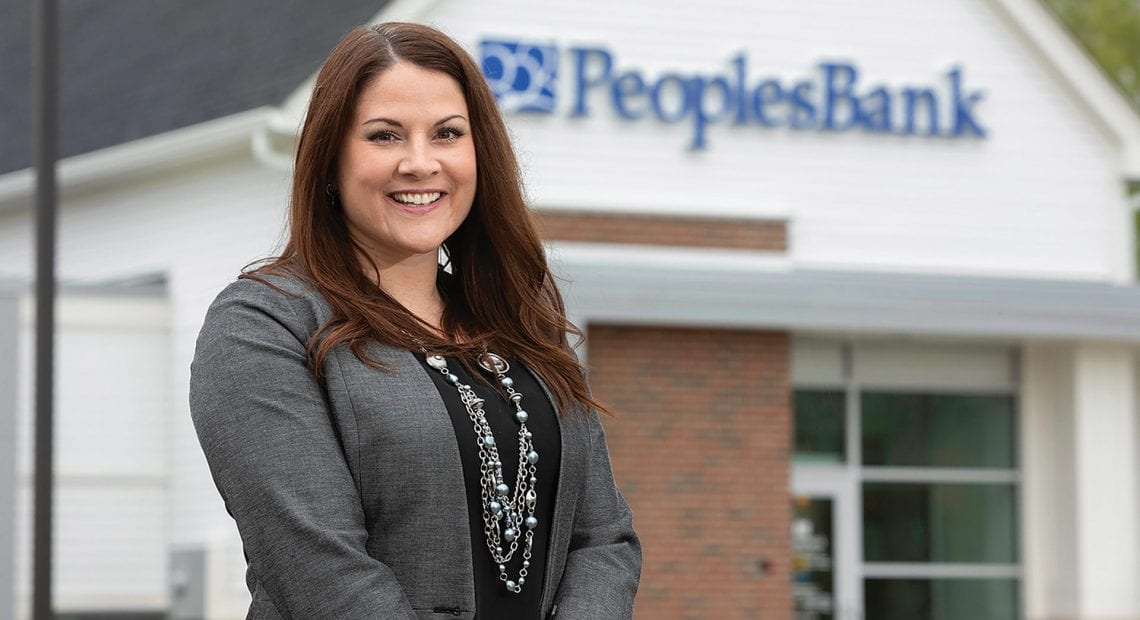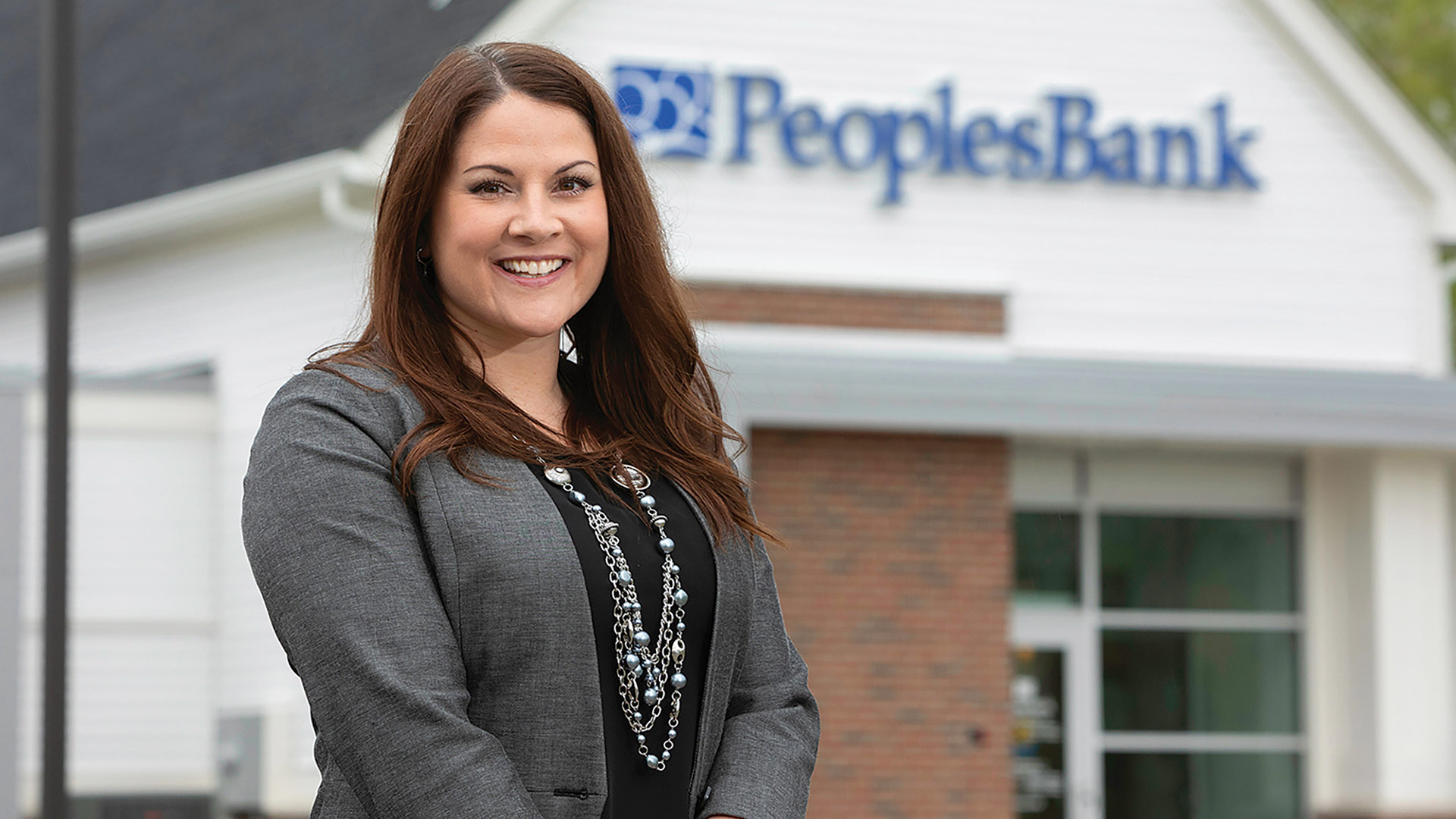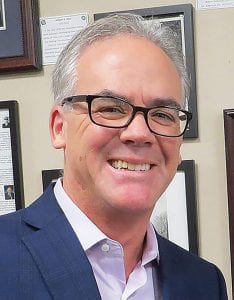
For Banks, Pandemic Has Been a Time of Adjusting and Learning
Making Change
As essential businesses that couldn’t shut down operations during the pandemic, banks and credit unions met some daunting challenges over the past year — both logistical and in meeting the needs of customers, many of whom were navigating difficult financial times. While things are starting getting back to normal now, the definition of ‘normal’ has shifted — and area banking leaders say they’ve learned some lessons they will certainly bring into the future.

Aleda De Maria says PeoplesBank’s call-center activity tripled over the past 14 months.
By Mark Morris
Winston Churchill gets credit for first remarking, “never let a good crisis go to waste.”
For bankers in Western Mass., the COVID-19 crisis was in many ways a chance to learn what works best for their customers and their workers.
While branch offices for most banks have reopened, they were ordered closed to the general public at the beginning of the pandemic, opening to customers only by appointment. As a result, many customers relied on online banking to handle routine transactions.
For those who needed to open an account, it was no longer necessary to visit a branch, as the entire process can be done online, said Aleda De Maria, senior vice president, Retail and Operations for PeoplesBank, who noted that new account applications doubled in the past year, and the use of mobile deposits is up nearly 40%.
“Customers who may have been reluctant in the past to try our online self-service channels are now using them,” she added. “We’ve also seen occasional users of these tools become more aggressive users.”
Because customers had plenty of questions amid the uncertainty of the past 14 months, De Maria reported a significant increase in activity on the bank’s phone lines. “Our call center tripled the volume of activity we would normally see. Now we’re back to what I would call a busy, but more normal level.”
As cars lined up at drive-up windows during business hours, many banks increased their use of video tellers to extend the hours tellers can be available. A video teller looks and functions like a standard ATM, but the customer can also reach a live professional when they have a more complex transaction.
“Customers who may have been reluctant in the past to try our online self-service channels are now using them. We’ve also seen occasional users of these tools become more aggressive users.”
“It’s as if you are standing in front of a teller,” said John Howland, president and CEO of Greenfield Savings Bank. “We had six of these in place before COVID, and they really worked well for us during that time when we could not allow people to come into the branches.” The bank has since added six more of its Teller Connect video tellers.
De Maria said video tellers made it possible to expand beyond normal business hours to even include Sundays.

Glenn Welch says credit-union CEOs have been discussing the future of hybrid work arrangements, since employees will expect that flexibility.
“We can now offer banking services seven days a week without us having to keep our banking centers open seven days a week,” she noted, adding that the pandemic made one point crystal clear: customers want options, now more than ever. “Customers want the flexibility to either interact with someone or not to interact.”
For this issue’s focus on banking and finance, BusinessWest spoke with several executives from local banks and credit unions about how they have weathered the past year, what lies ahead, and what they — and their customers — have learned.
From a Distance
In addition to new ways of serving customers, banks were challenged to become more flexible with their employees, many of whom were forced to work from home.
Glenn Welch, president and CEO of Freedom Credit Union, recalled that, at the height of the pandemic, 30 employees worked exclusively from home while another 30 split their time between home and the office. Now, 47 employees are taking a hybrid approach of splitting their work time between the office and home.
“Going forward, employees are going to expect to have an option for some kind of hybrid between working at home and the office,” Welch said, adding that an online forum of credit-union CEOs recently discussed how a hybrid approach might work. “The consensus is to bring people back to the office as much as possible while still allowing them the flexibility to work from home probably one or two days a week.”
“The consensus is to bring people back to the office as much as possible while still allowing them the flexibility to work from home probably one or two days a week.”
John Bissell, president and CEO of Greylock Federal Credit Union, said 176 of his employees work from home right now, and he has no immediate plans to require a mass return to the office.
“In fact, we are so confident in the success of the work-from-home model that we are consolidating one of our branches with a nearby operations center,” Bissell said. While Greylock has no plans to permanently close branches, it is looking into shared-space arrangements to increase efficiency and save on future real-estate investments.
All the bankers agreed that, when possible, they prefer personal interactions with their employees and customers. When that’s not possible, they are grateful for advances in technology that have made it easier to work from home. Sometimes it results in seeing certain jobs in a different light.

John Howland says some positions, such as those in loan processing, are more suited for a remote setup than others.
“I never thought I’d say this, but there are some situations where the business and the task is better suited to work remotely,” Howland said, citing certain loan-processing positions as one example. “Because all the documents are electronic, it’s easy to measure a person’s productivity without looking over their shoulder.”
Bissell admits this past year has helped him understand how the pandemic affects employees in different ways.
“Those with school-aged children or who are caregivers have different needs than those who may be at risk themselves or have a partner who works as a first responder,” he said. “We must pay close attention to employee needs and build in opportunities to meet them where they are.”
Whether employees worked in the office or from home, they all stayed busy with mortgage applications for people buying new homes and for those looking to refinance at historically low interest rates.
“Our mortgage business was up nearly 65% last year,” Welch said. “As fewer houses are available for sale, we’re making up some of that slack in the refinancing area.”
He predicts slower growth could loom on the horizon, however. “There are only so many people who can refinance, and when you have less housing inventory to sell, it suggests a slowdown in the mortgage business may be coming.”
While the mortgage market is still active, Bissell pointed out there is a greater demand than housing supply, so Greylock is trying to help increase the supply. “We are partnering with local leaders to look at ways to stimulate development of more housing across the pricing spectrum,” he said, with the goal of a healthy housing market that is accessible to all members of the community.
On the flip side of new mortgages, job losses during the pandemic made staying current on mortgage payments a burden for many.
“We anticipated that people would have trouble when COVID hit,” Howland said, “so we allowed people to defer their mortgage payments without having to substantiate they had a need.”
By All Accounts
The pandemic — and the economic shutdown it ushered in — challenged business-banking clients as well, and for the first round of Paycheck Protection Program (PPP) loans, Greenfield Savings Bank created a task force of 43 employees to help local businesses process their loan applications. Employees often made calls on the weekend to clarify any point that might slow down the process. Several applicants received calls from Howland himself.
“It was amazing that no one complained for calling them at 8 p.m. on a Saturday,” he said. “They were all just happy we were working on their behalf.”
In the first round of PPP, Greenfield Savings processed 720 loans totaling around $60 million, and followed up with nearly the same amount in the second round. Meanwhile, the business-banking team at Greylock secured $30 million in PPP loans, which Bissell said helped save nearly 4,000 jobs in the Pittsfield area.
As everyone tries to figure out what lies ahead, bankers remain optimistic. Like every institution, Freedom Credit Union saw a surge in deposits after $1,400 pandemic-relief checks began landing in accounts, Welch noted. “People have only spent about 25% of their government checks, so there’s lot of pent-up demand out there.”
While banks had been increasing their use of technology anyway, industry data suggests COVID accelerated that shift by at least five years. Based on that trend, Welch sees bankers moving toward more of a consulting role.
“I think, eventually, people will visit a bank or credit-union branch when they need financial advice such as buying a home or a car,” he said. “Increasingly, they will handle their routine transactions online.”
Video teller machines are another example of the increased use of technology for everyday transactions.
“I think the pandemic made customers more willing to try new technology that we hadn’t offered before,” De Maria said. “We’ve seen some real success in their adoption of tools like our video banker.”
Still, while bankers are pleased with how well customers have adjusted to making technology part of their banking routine, they all look forward to the time when in-person banking becomes normal once again.
“When you get down to the basics, we provide relationship-based financial services,” Bissell said. “It’s really about personal relationships.”
In addition to engaging customers again, Howland said the camaraderie and collegiality of the staff being together is also essential.
“I’m a big believer in the small talk around the water bubbler,” he said, adding that the pandemic robbed people of those everyday social interactions that were taken for granted in the past.
“We are looking forward to a routine where we see our customers on a regular basis and we can have that friendly conversation once again,” he went on. “Everyone in our company is looking forward to that happening.”




